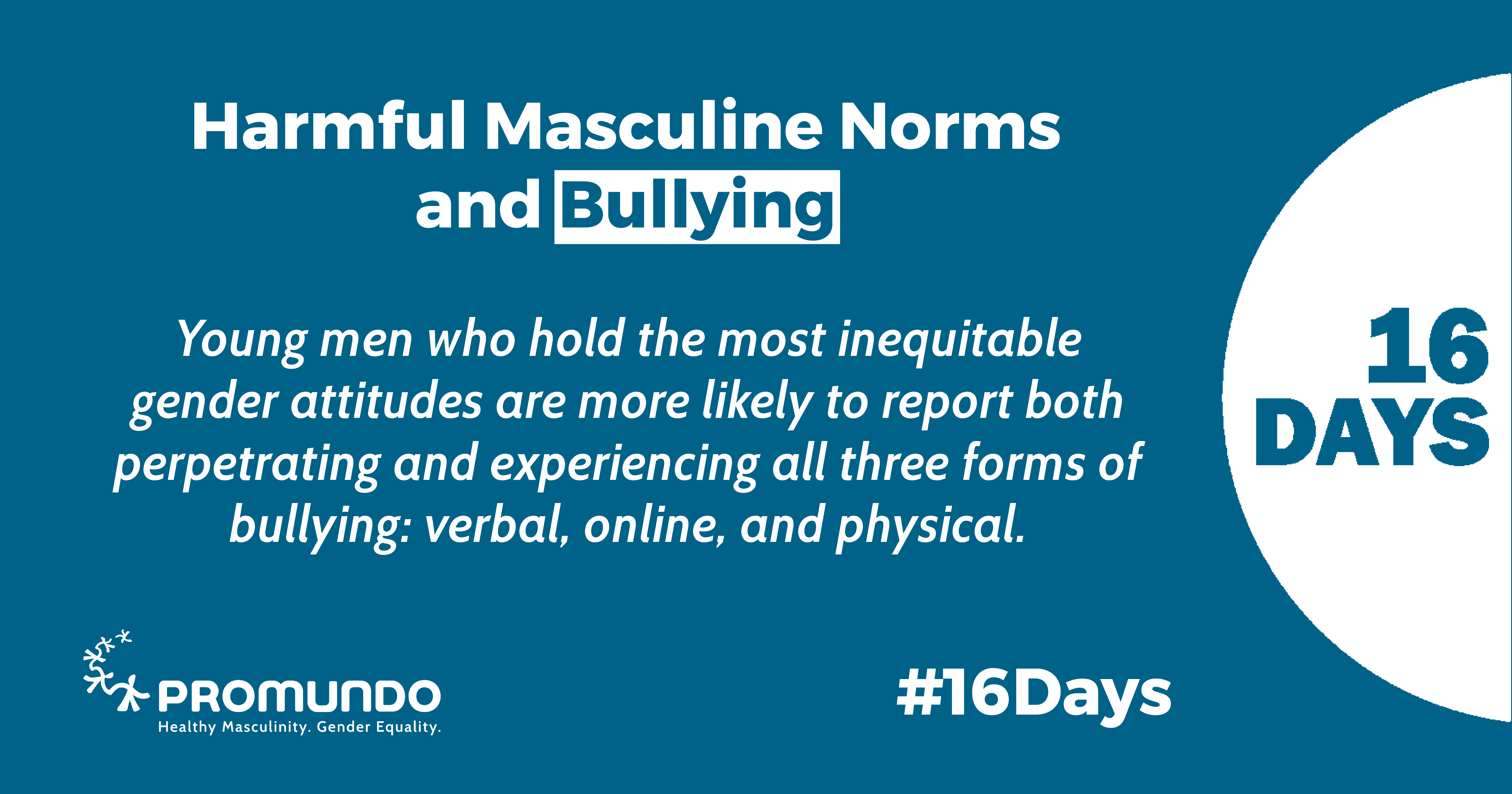Les 16 jours d’activisme contre la violence sexiste sont une campagne internationale utilisée par des militants du monde entier (du 25 novembre au 10 décembre) comme stratégie d’organisation pour appeler à l’élimination de toutes les formes de violence sexiste.
Cette année, nous partagerons des recherches sur les liens entre les normes masculines néfastes et huit formes différentes de comportement violent, ainsi que des idées et des recommandations pour éliminer toutes les formes de violence.

Même si le fait d’être un homme n’a rien d’inhérent à la violence, la manière dont nous socialisons les garçons dans leur identité d’homme et ce que nous attendons d’eux – c’est-à-dire les normes masculines de la société – sont indéniablement liés à la violence.
En effet, les garçons et les hommes sont souvent élevés, socialisés et encouragés à recourir à la violence sous une forme ou une autre ; dans l’ensemble, ils sont plus susceptibles de commettre la plupart des formes de violence et de mourir par homicide ou suicide. Cependant, les recherches confirment que cette violence est évitable, que l’égalité des sexes est réalisable et que les normes et idées non violentes sur la virilité sont répandues et puissantes.
Rapport d'Equimundo et de la Fondation Oak Normes masculines et violence : établir des liens, examines the links between harmful masculine norms and eight forms of violent behavior. This fourth blog in the Établir les connexions16 jours d'activisme series focuses on bullying. It breaks down the facts on bullying, explores its linkages to other forms of violence, and provides recommendations for action.
Bullying
Les faits
Bullying by men and boys takes many forms. In a 2017 study, La boîte à hommes, more than one-third of young men in the United States, the United Kingdom, and Mexico reported having perpetrated verbal, physical, and/or online bullying in the month prior to data collection.
Being a victim of bullying is a common experience for young people, and some youth are aware that identifying as LGBTQIA+ was a reason behind their being bullied. Youth who do not conform to social norms related to gender and sexuality are at the highest risk of being bullied.
Children often experience bullying differently. Boys are more likely to be recognized by others as victims of bullying. However, boys are more likely than girls to experience harmful – rather than helpful or supportive – public acknowledgment of this victimization.
Les liens
Masculinities are often at the root of men’s perpetration of bullying. In La boîte à hommes study, young men who held the most inequitable gender attitudes (about a variety of themes, not only violence) were significantly more likely to report both perpetrating and experiencing all three forms of bullying: verbal, online, and physical.
Research suggests that bullying behaviors often share common root causes: the perpetrator’s desire to demonstrate power and control over the victim, and the use of bullying to enforce gender conformity. Many researchers conclude that gender identity and violent gender norms contribute to bullying, alongside many other interwoven factors.
Bullying can provide a pathway to achieve or maintain social status within group settings such as schools and workplaces.
Les intersections
Any thorough explanation of bullying behavior must include influences beyond dominant, or hegemonic, masculinity. Analyses of these causes identify a variety of intersecting levels of influences: the individual, family influences, peer influences, school influences, and community/cultural influences (including poverty and media influences).
Children who are exposed to contexts and relationships with extensive conflict, hostility, and abuse are more likely to perpetrate bullying, a finding similar to other forms of violence for which there is intergenerational transmission. Hostile family and educational environments have been consistently found to be risk factors for bullying.
Physical location, social context, and age intersect with and normalize boys’ and men’s perpetration of bullying. For instance, in school contexts, boys’ physical aggression is often legitimized as “boys will be boys,” whereas the same behavior by girls raises questions, and the same behavior by a middle-aged man in a work setting might be considered inappropriate.
De la théorie à la pratique
Very few bullying-prevention programs, particularly in the Global South, work to deconstruct harmful masculinities. Initiatives aiming to prevent bullying should focus on the following transformations of harmful masculine norms:
- Engage individuals of all gender identities in discussions about how traditional gender norms and gender nonconformity are connected with perpetration and experiences of bullying.
- Explain, illustrate, and discuss the direct connection between the perpetration of bullying and power, control, and social acceptance, being careful to do so in a way that invites self-awareness rather than places blame.
- Provide participants with a safe space to practice nonviolent, healthier ways to navigate peer groups and social dynamics.
- Discuss ways that participants can foster group settings and peer networks that value healthy expressions of masculinity and embrace, rather than punish, individual differences.
